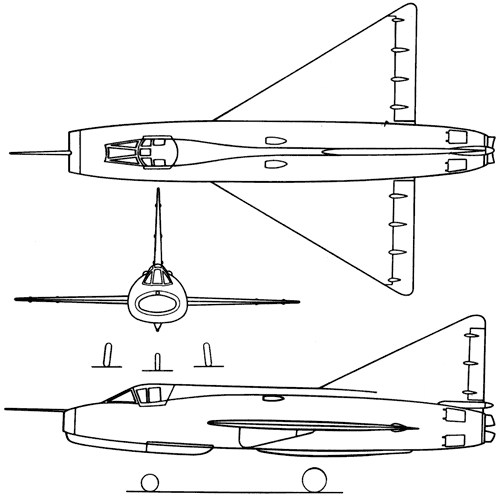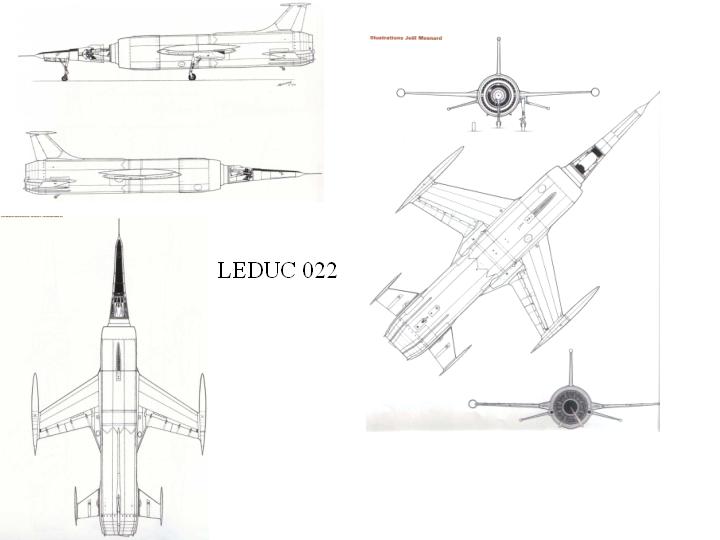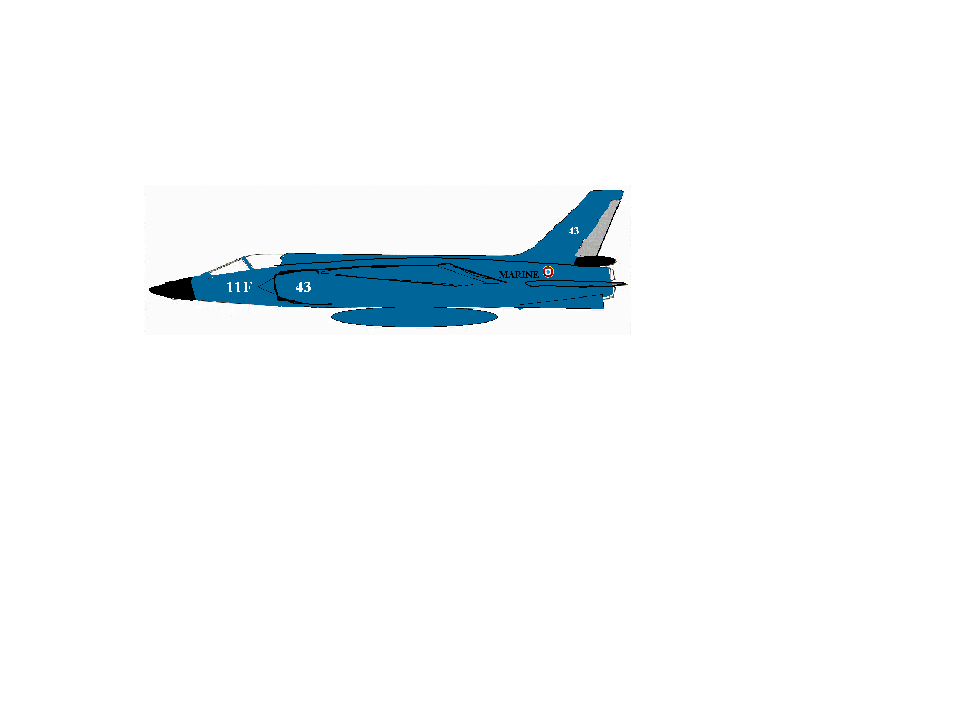Armée de l'air 1958 : new airplanes...
Armée de l'air 1958 : so much airplanes...
In 1956 there was many interesting airplanes prototypes in France. The AdA have three new missions to fulfil
- All weather strike
- Long range, nuclear strike
- All weather, high height, long range interception.
For these missions, a lot of airplanes were tested. In those times, 6 firms were able to make combat airplanes
First were private firms
- Leduc
- Breguet
- Dassault
Then were an equal number of public firms
- SNCASO
- SNCASE
- SNCAN
SNCA means "National Society Constructor Airplanes". The one or two letters at the end are geographic places were the firms were (Toulouse, Cannes…) (N = North , SO = South West , SE = South East).
On 1st March, 1957 the two "southern" firms SO and SE were merged and formed "Sud Aviation".
Starting in 1955,with a peak in 1958, all these firms studied many mach2 projects; all made their own mach2 prototype.
So the AdA had plenty of choice…
Starting in 1956, all the old fighters bombers were sold or scrapped (from the Ouragan to the Mystère IV). AdA wanted a brand new, huge number of fighter-bombers.
First it was decided to convert the 180 SMB-2 order. The SMB-2 was a mach1.2 interceptor; but it was obsolete because mach2 fighters and bombers started to enter service in the same year it flew, in 1957. Fortunately, Dassault had made a better version, the SMB-4 which flew at mach1.4 with a much powerful Atar-9. This too was obsolete as interceptor, but it was decided to transform this type in a powerful tactical fighter (as the F-100).
Hardpoints were added underwings and underbelly; the plane was able to carry 8 bombs, or 6 rocket pods (with 50 rockets each). The SMB-4 become the mainstay of French ground attack and close air support. 225 were bought. A test was made at the CEV to determine the maximum number of SNEB rocket pods it could carried : the answer was 8!!! Range was ridiculous, but fire power enormous : 400 30mm-rockets per airplane !! The tactic was to launch four planes, attack at full speed and treetops, then separate, make a brief climb and dive on troops concentrations, fire all the rockets at the same time, to create a massive blast and break the armoured attacks. A special rocket, with a napalm warhead was created to augment the blast and effect of the attack.
AdA learned the lessons of the Arromanche attack on 31 July 1944, when Typhoons destroyed 175 Germans armoured vehicles on the same day, killing any counterattack possibility.
The problems of interceptors was much complex.
First was the problem of Mach2 interceptors : AdA clearly specified that only turbojet powered interceptors would be admit (no rocket or ramjets). Dassault thought he has won with the Mirage III, but a competitor appears : the SNCASE Durandal.

In April 1956, the Dassault Mirage III-01 was not to fly until eight months (November 1956). The trouble was that the SNCASE, a public firm, create the Durandal and this fighter flew in April. It was very similar to the future Mirage III : a delta wing, the same turbojet (Atar 101, 4500kgp) and had the same performances (mach1.6 with this weak engine, waiting for the most powerful Atar-9 to reach mach2). The only difference was the air intake, frontal (as in the F-100). SNCASE had a Durandal IV project, which was really a Mirage IIIA equivalent. When SNCASE merge with his SO counterpart, the project was put on hold; but as the rocket powered trident (SO mach2) was no match for the Mirage III, the Durandal IV was resurrected. Of course, the frontal air intake caused problems, but this was solved as in the F86D, putting a nose cone above. So the Durandal V had a radar, too. The competition between the two was harsh, as the brand new Sud Aviation was the most powerful of public firms , and Dassault as usually lobbied hard. The AdA choose the two fighters, buying 100 Mirage IIIC and 100 Durandal VC. Both had Cyrano radar and were R530 able.
At the same time, French Government heard of the M50, M52 and M56 bombers; the last was to fly were high, up to 90000fts. Neither the Durandal V nor Mirage IIIC could fly up to 75000fts; as a consequence, 50 of 110000feets-capable rocket powered Tridents III were bought.
A twin-engine, heavy fighter was proposed by Dassault, the Mirage IVC and raised much interest in the AdA.
But the AdA first wanted a long range strike plane.
Dassault proposed a stretched Mirage IVC , the Mirage IVA to carry the future A-bomb at mach2 over 2500km range.
The SNCASO was the only competitor to Dassault , with a very different approach. The project was based under the SO-4050 Vautour light bomber. A first draft, the SO-4060, was a mach1.4 Vautour. SO quickly understood that this plane was no match for the Mirage IVA, and search a different way. The solution was to keep on with the "ordinary" Vautour, starting from the two seat night fighter Vautour IIN. First to change were the engines; they were replaced by unreheated Atar-9, offering 4500kgp of thrust. This was 1000kgp better than the old, and diminished a lot fuel consumption. The Vautour was now able to fly at mach1.05 in flight level at 40000fts, or mach0.97 at treetops. The electronics was borrowed from the Mirage IIIE project (an all weather attack version of Mirage IIIC which never left the drawing board); this was the terrain following, air-to-ground radar Cyrano II, a very sophisticated equipment for the time. The mission profile was much different from the Mirage IVC proposal : the Vautour IIIN was to fly very, very low at high subsonic speed, using terrain to avoid detection.
The SO proposal was backed by the GB example; the RAF and RN made opposite choices at the time. RN choose a high subsonic, low level attack plane (the Buccaneer) whereas the RAF choose the GOR339 a mach2 bomber. Only the Buccaneer entered service and was very successful for years.
The Vautour was finally elected as low-level, long range nuclear strike bomber; performances were so impressive (ferry range was 4500km!) that a non-nuclear strike version was made. 86 Vautour IIIN and 125 Vautour IIIE were bought by the AdA.
The Vautour had good self defences abilities (ask the Israelis) but to enter USSR airspace it needed a strong backing. The escort plane selected was the Mirage IVC, a superb twin-engine, delta wing fighter. This was France answer to similar CF-105 Arrow and Delta III. The Mirage IVC was first developed into a long range interceptor (1850km). It could fly to mach2.35 with two Atar-9K (6800kgp). His armament was impressive : four R-530 medium range air to air missiles were recessed under the belly; up to four AIM-9 could be carried under the wings. Alternate loads were three drop tanks, two 2500 litters under the wings, and one 3000 litters under the fuselage. The range was tremendous for a fighter (nearly 2800km). Its aim was to make long range interceptions over east Germany, or to escort the Vautour IIIN in their nuclear raids. A recon version was developed, too, the Mirage IVR, and also an electronic countermeasure one (Mirage IVE).

In 1965, the AdA had a tremendous strength : it had 250 short range interceptors (Durandal VC, Mirage III, Trident) 180 long range interceptors (Mirage IVC) , 225 close to air support aircrafts (SMB-4) and 206 long range strike bombers (Vautour IIIE/N).
In 1958, De Gaulle goes back to the power; he had "a certain idea of France". He wanted a lot of records. The Trident III, Griffon II and Leduc 022 were selected. Their goals : breaking height, speed and climbing rate record. The three impressive planes were carried to Istres, were the records were prepared.
First was Trident II : on 17th November 1958, with Carpentier at the controls, it took off from Istres, reach mach 1 on its two Gabizo engines. Then, Carpentier light the 4500kgp rocket motor and the plane quickly broke the 100.000ft barrier, reaching a peak at 107500fts.
After that was the Griffon II : in 20th February 1959, using both is new Atar-9 engine and his powerful ramjet, the plane reach the highest climb rate ever, more than 55000ft/mn. Then was the most impressive record, the speed.
In December 1959, a F-106 Delta Dart reach 2480km/h in level flight. The Leduc 022 number 2 was prepared to break this record, and be the first plane to fly at more than 2500km/h, (or even if mach3 if possible, De Gaulle asked). On 25 February 1960, Jean Sarrail was at the controls. The plane had, too, atar-9 and ramjet, but was made of steel (unlike the Griffon, which was made of light alloys thus limiting its speed to Mach2.19.). Sarrail climb to 60.000fts only on the power of the atar-9 and quickly reach Mach2.3. then he light the ramjet and the plane started to accelerate in an impressive way, finally reaching Mach3.05, more than 3200km/h!!!
De Gaulle was very satisfied , and the three pilots received the Legion d'honneur medals in 1961at the Elysée palace.

The Marine Nationale had, too, an urgent need for new aircrafts carriers and new interceptors. As the public and private firms were very busy with their record attempts or the enormous buying of the AdA, Breguet was selected to make a particular mach2 fighter. The Durandal and Mirage III were unable to land on a carrier because of their delta wings. Breguet create the 1120 Sirocco fighter (with GB collaboration) and this enter service in 1965 on board of Clemenceau Foch, Verdun, Ark Royal and, later, CVA-01aircrafts carriers. The Sirocco (Cyclone for the British version) was able to carry a AN-22 tactical nuclear bomb on his centreline pylon, thus enabling Aeronavale to make nuclear deterrent.
